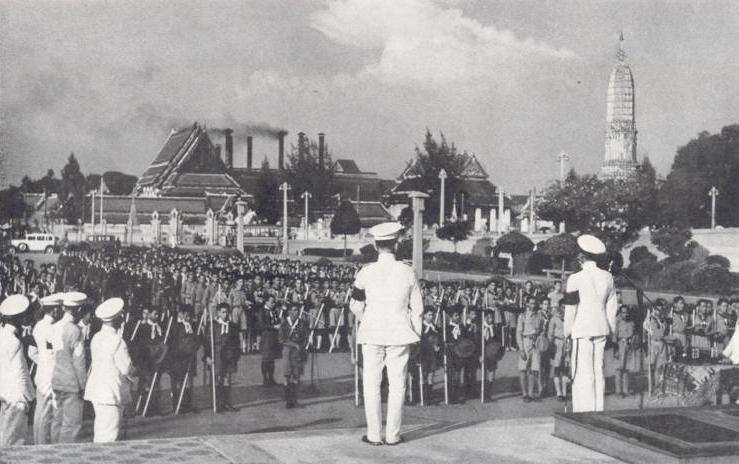
Thai Nationalist Youth Groups: Yuachon

Figure 1.--This 1941 magazine photo shows Yuachon members taking the Oath of Fealty in Bangkok. The caption read, "Boy Scouts and Youth Movement Members Take the Oath of Fealty in Bangkok: For 30 years Boy Scouts have flourished in Thailand. The Youth Movement [Yuachon] was organized eight years ago, folloiung assession to the throne of boy king Anamda Mahidol, now 16 years old. He became ruler when his uncle, the late King Prajadlhopok abdicated in 1935, but he lives in Europe. Thiland is giverned by Luang Bipul Songgram, a virtual dictator who has built up a small but modern army, navy, and air force."
|
|
The Japanese negotiated with the Thai Government, the only indepedent country in Southeast Asia, before launching the Pacific War. The Thais without the military capability to resist the Japanese and with a Fascist oriented government, joined the Axis. Thus the Japanese did not invade Thailand when they launched their Burma campsign from Indochina (January 1942). Rather the Thais allowed the Japanese to pass through their territory. They this did not interfere with the three youth groups operating in the country (Boy Scouts, the Yuachon, and the Military Cadet Corps) or sposor a new pro-Japanese group. Pro-Japanese Premier Pibul did significantly change Thai Government policy toward youth groups. The Pibul Government did not ban, but reduced government support for the Scouts. The Yuachon youth group was Fascist youth movement modeled on the NAZI Hitter Jugen and strongly promoted by the Pibul Government. The group was actually founded by Pibul when he was Minister of Defense (1935). The purpose was to promote physical culture, general discipline, and "organized cooperation". After Pibul became premier, the Pibul program began to change (1938). The program was expanded to include military courses. And the ethos of the group shifted to a kind of blind obedience to Premier Pibul. It was not a mass movement. Membership was voluntary. There were several enducements appealing to some boys, including smart uniforms, raining with weapons and other military equipment, partial exemption from conscription, and the possibility of becoming an Army officer. Membership was about 6,000 boys (1941) and 25,000 (1944), about 90 percent in the younger age group. The Yuachon was jointly operated by the Ministries of Education and Defense, but at the end of the War became a "department" of the Thai Army. It was enamed the Department of Preparatory Military Affairs. Since the Aphalwong regime came Into power, however, Yuachon activities nave not been publicized. [OSS}
Sources
Office of Strategic Services (OSS), Research and Analysis Branch. "Japanese attempts at indoctrination of youth in occupied areas, " R&A 2982S (March 23, 1945).
HBU

Navigate the Historic Boys' Uniform Chronology Pages:
[Return to the Main chronologies page]
[The 1900s]
[The 1910s]
[The 1920s]
[The 1930s]
[The 1940s]
[The 1950s]
[The 1960s]
[The 1970s]
[The 1980s]
[The 1990s]
[The 2000s]
Navigate the Historic Boys' Uniform Web Site:
[Return to the Main nationalist country page]
[Return to the Main Thai country youth organization page]
[Activities]
[Biographies]
[Chronologies]
[Countries]
[Essays]
[Garments]
[Organizations]
[Religion]
[Other]
[Introduction]
[Bibliographies]
[Contributions]
[FAQs]
[Questions]
[Unknown images]
[Boys' Uniform Home]
Navigate the Historic Boys' Uniform Web organizatiion pages:
[Boys' Brigade]
[Camp Fire]
[Hitler Youth]
[National]
[Pioneers]
[Royal Rangers]
[Scout]
Created: 4:13 AM 12/4/2009
Last updated: 4:13 AM 12/4/2009


